by Editor | Jun 15, 2015 | Luxury Travel
By Elena del Valle
Photos by Gary Cox
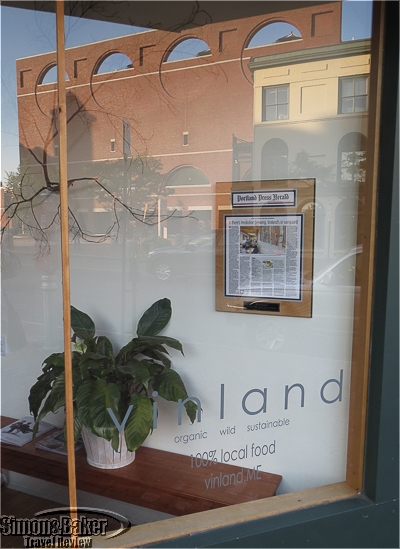
The front window of Vinland faces the Portland Museum of Art
The theory of locally sourced gourmet meals offered by Vinland restaurant in Portland, Maine appealed to us. Wondering how well theory translated to practice we made dinner reservations. We were pleasantly surprised.
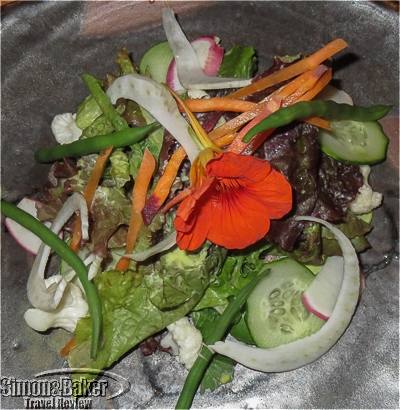
The salad of local greens and herbs
The first thing we noticed was the minimalist décor with an open kitchen in the back of the single space and the warm welcome (Dylan and Timothy looked after us) and ambiance. Wood floors and few adornments lent it a streamlined functional appearance. The armless seats were less than comfortable, and by the end of the meal we were eager to leave just to part company with the seats. In the rear there was a unisex bathroom.
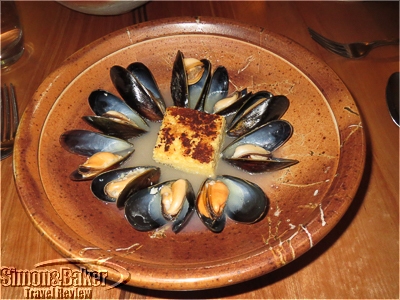
The mussels with polenta
The menu featured multi-plate options as well as an 18-item tasting menu, and wine pairings. On our first visit, we sampled the multi-plate menus. For the following dinner, we opted for the Tasting Menu with wine pairing to get a broad sampling of the cuisine and celebrate a special occasion. Wines were biodynamic, natural (unfiltered, wild fermented and without sulfites) or wild fermented.
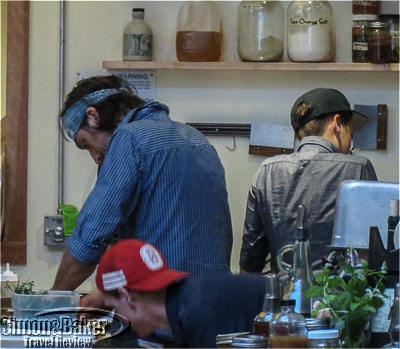
The open kitchen allowed diners to watch the chef and his staff at work
From Beet chips served with crispy beets, chevre cheese and micro greens to the messy but nice mascarpone Buckwheat Fennel Seed Cookies at the end, and the Austrian, French, and Italian wines by the glass paired to the menu we had a most enjoyable and unique dinner.
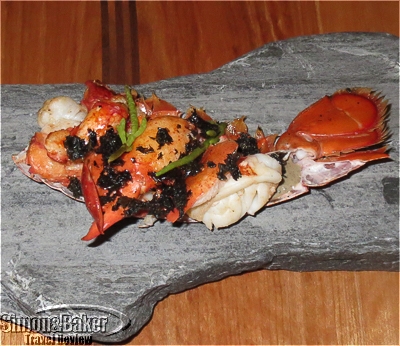
Locally sourced lobster served on a stone platter
As the evening progressed the dining room filled and the noise level grew. Staff became busier although we were not neglected. We appreciated our meals at Vinland and look forward to dining there again the next time our travels take us to Portland.
by Editor | Mar 16, 2015 | Luxury Travel
Article and photos by Elena del Valle
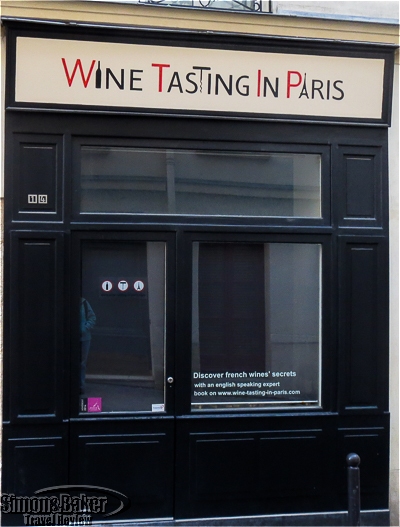
The entrance to Wine Tasting in Paris on an old cobblestone street
Understanding and appreciating wine is a personal and subjective experience, one I always feel the need to improve. Each time an opportunity presents itself for me to grow my knowledge and exposure to wines I jump on it. And what better place than Paris, France while I had time to spare? When I heard about a new program in English I was immediately interested. Hosted by Thierry Givone, a native of Burgundy, the French Wine Tour, a two hour hands on workshop was engaging and fun. Thanks to its central location I was able to walk there from my temporary Parisian home.
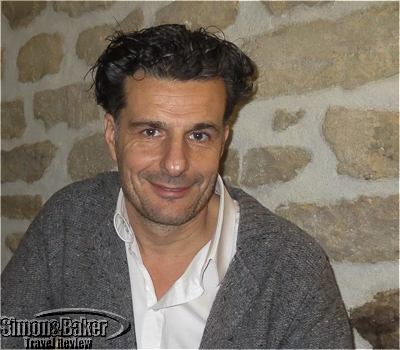
Thierry Givone, a native of Burgundy, hosted wine tasting workshops in English.
Following self introductions and a brief video presentation by our host, six of us, all Americans coincidentally (while Americans represent half of his clientele, many British, Canadians, Australians, and Europeans attend as well) tasted and discussed six wines ranging in retail price between 12 and 20 euros. They were, Champagne Brut Reserve from Thierry Massin; Sauvignon blanc Eclat de Silex, from Domaine Michaud, in Loire Valley 2013; Chardonnay Macon La Roche Vineuse from Domaine Merlin in Burgundy 2013; Pinot Noir Mercurey from Chateau de Santeney 2009; Bordeaux Chateau D’arcins Haut Medoc Cru Bourgeois 2011; and ORTAS, From Caves de Rasteaux, in Rhone Valley 2012.
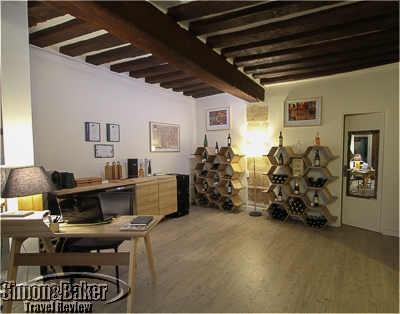
The main area of Wine Tasting in Paris (click to enlarge)
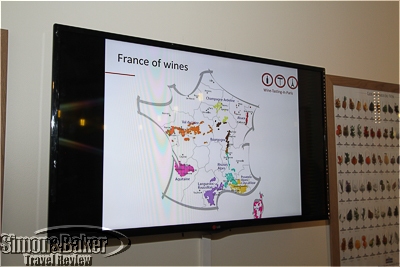
Givone relied on a flat screen television for his presentation.
“I hope the quality of my welcome, from the confirmation e-mail to the recommendation of what to do or where to go after the tasting,” said Givone when asked what makes his programs special in a city filled with wine and gourmet tasting possibilities. “Individual interaction, the fact that I created the company and I animate all tastings myself, with passion and involvement, when other companies just drive the business and hire free lance sommelier for the animation. The atmosphere of my space, in this nice street, with a small tasting room where people feel very well. I’ve tried to create a ‘tour’ with a good combination of global information, details, historical facts, fun facts, and personal experience, so that people have learned things and had a great moment.”
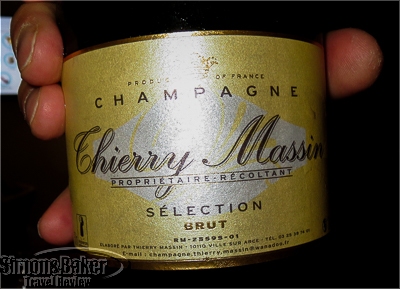
The champagne selection from Thierry Massin
Givone’s first job was as marketing manager in a French subsidiary of an American group. In 2013, he established Wine Tasting In Paris (14 Rue des boulangers, 75005 Paris, France, + 33 676 933 288, www.wine-tasting-in-paris.com, thierry@wine-tasting-in-paris.com) at another location. The course I attended took place in a 45 square meter two room space within a building that may date to the XVII century, near metro stations Cardinal-Lemoine and Jussieu. The cobble stoned street itself was already in existence in 1350.
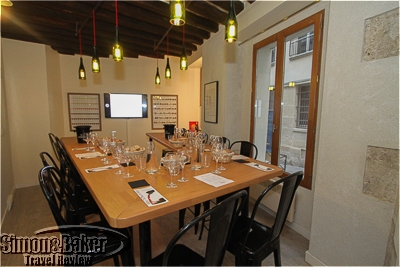
We spent most of the time at the table, watching the presentation and tasting wines. (click to enlarge)
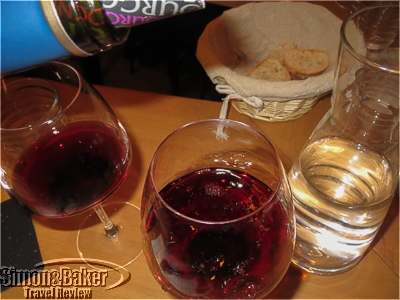
We each had wine glasses, bread and water within reach.
Givone, a fan of wines from his native Burgundy, rounded his wine education by spending time at Wine and Spirit Education Trust (WSET) at the Ecole du Vin in Paris, Wine School of Bordeaux, and Wine University of Cotes du Rhone. The way to taste was by looking, smelling and tasting a wine, he explained. He recommended that we smell the wine before swirling it in the glass to smell it a second time before tasting it.
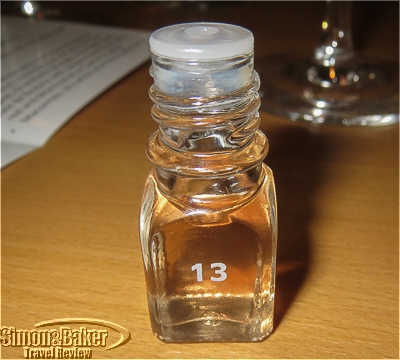
A smell aid we used to practice identifying scents
He relied on synthetic smell aids in an exercise designed to teach us to identify the range of flavors found in wines. They were flower, fruit, vegetable, earthy such as mushrooms and forest, spices like pepper and vanilla, wood, toasted aromas, mineral, balsamic, animal and chemical or foreign. He described the varied flavor zones of the tongue. We can taste sugar on the tip, acidity and salty flavors on the side and bitterness in the back, he explained.
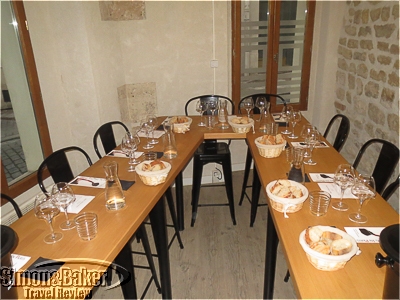
The custom made table allowed everyone to see the presenter.
The meeting room featured a modern design and wood furniture. The tasting table with a V shape was custom made according to his specifications to allow up to 12 guests a good view of the presenter and the large wall mounted television screen. At the same time, it allowed him to stay in the middle to pour of wine for each tasting course. We plucked pieces of sliced baguette from the bread filled baskets nearest each of us to cleanse our palates between wines. As the workshop ended several of us lingered and bought wines to take home and sample at leisure or with a meal.
by Editor | Jan 1, 2015 | Luxury Travel
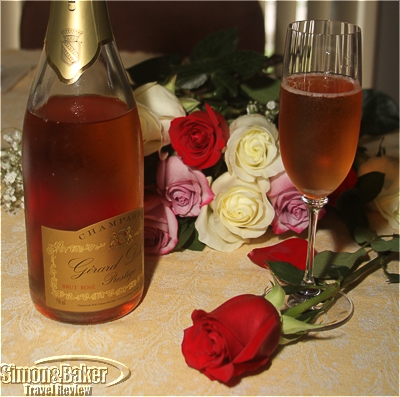
From all of us at Simon & Baker Travel Review and Luxury Travel Review!
by Editor | Oct 20, 2014 | Luxury Travel, Products
Article and photos by Gary Cox
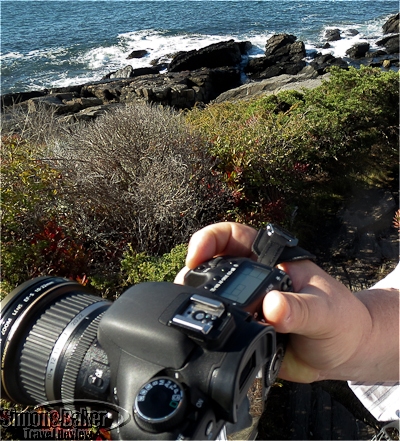
Using the Clutch I held the camera in position, ready to shoot during a cliff side hike
I had a chance recently to field test the Slide and Clutch camera straps from Peak Design. Prior to using the new straps, the Canon EOS-7D SLR I use when traveling sported the manufacturer supplied neck strap and I rarely gave it a second thought. It was a bit annoying when using the tripod to have the strap hanging off the camera, but it was too much trouble to remove or even adjust the old fashioned length clips, except in extreme circumstances.
When walking around to photograph a property or a destination, the strap provided a measure of safety to avoid dropping the camera, but I had to be alert and hold the camera in my hands to prevent the lens or body from smacking against something and being damaged. When hiking, I usually place the camera into a padded pack or case. With the camera securely packed away, I noticed a tendency to only pull it out and use it at particularly special spots, sometimes passing up shots that I would regret later. Holding the camera with the Clutch make it more likely for me to take those spontaneous photos, and for that I was glad.
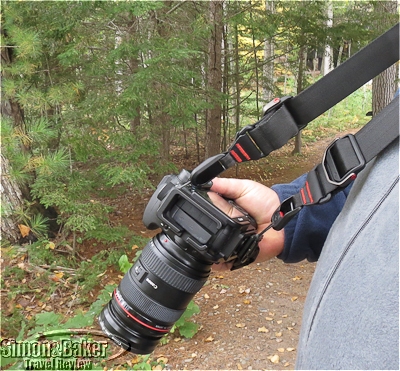
The Slide shifted the weight of the camera away from my hand during long walks
The Peak Design straps offered some noteworthy innovations that made it easier to carry the camera securely and be ready to take a shot at anytime. The Clutch was a surprising pleasure to use. It allowed me to hold the body securely with my hand positioned to shoot. I adjusted my grip using its small strap to fit my hand snugly in place. Adding the Slide strap made it easy to carry the camera along on a hike, ready to shoot at all times, while shifting the weight to my neck. The Slide strap was sturdy, made from the same material as vehicle seat belts, and reinforced with padding in the center. It was simple to adjust the length of the Slide by opening the clips, moving the strap through them and locking it securely.
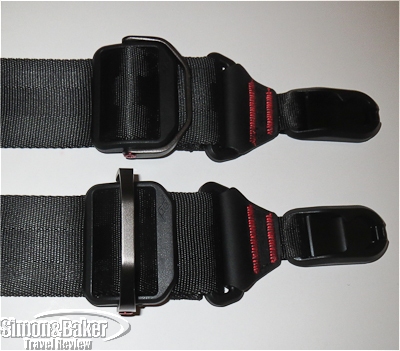
The quick release clips made length adjustments easy
The Anchor Link quick-connectors attached the Slide to the camera body and the bottom of the Clutch. The top of the Clutch attached directly to the camera, with a quick release spring to prevent accidental release. A plate provided with each strap could be mounted onto the bottom of the camera body using a standard screw. Multiple quick-connectors could then be attached to the plate. I prefer to use my custom fit plate from Kirk Photo on the camera body because it allows me to turn the camera sideways on the tripod and provides a stable surface to set the camera onto (provided the attached lens is not too heavy). Fortunately, my Kirk Photo plate includes a nice little slot to mount the quick-connectors. Aesthetically speaking, I prefer the sleek lines of my single plate which is custom shaped to the Canon body and will not twist or turn when I adjust the camera on the ball head.
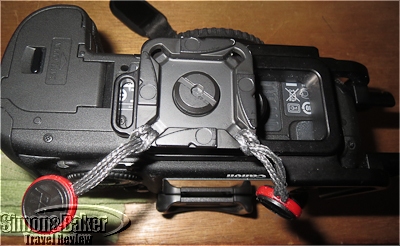
The plate supplied with the straps provided four mount points
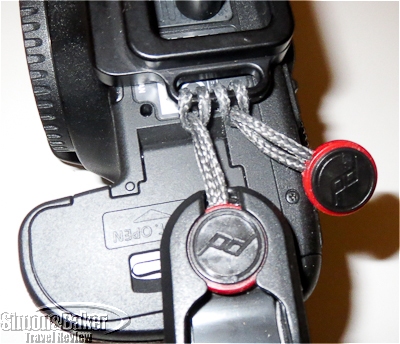
My Kirk Photo custom plate also provided a useful mounting point
The quick-connectors allowed rapid attachment and removal of the straps, perhaps my favorite feature. They gave the set-up solid feedback, and could support 150 pounds each, according to the manufacturer. The interlocking of the lozenge shaped anchor into the clip provided easy visual confirmation that the strap was secure. With a few extra Anchor Link quick-connectors on hand, my spare camera body can be ready for action quickly. All it requires is that I move the straps. I liked being able to remove the strap when placing the camera onto the tripod, eliminating one potential tipping hazard. I never found it necessary to detach the Clutch, other than when I was playing with different configurations of the Sling, a few of which used the top attachment point on the camera body.
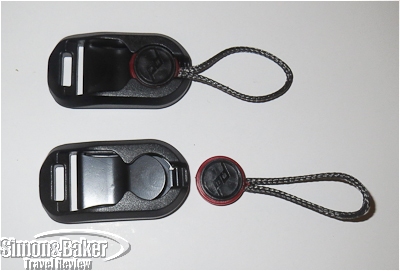
The Anchor Link quick-connectors attached the straps to the camera securely
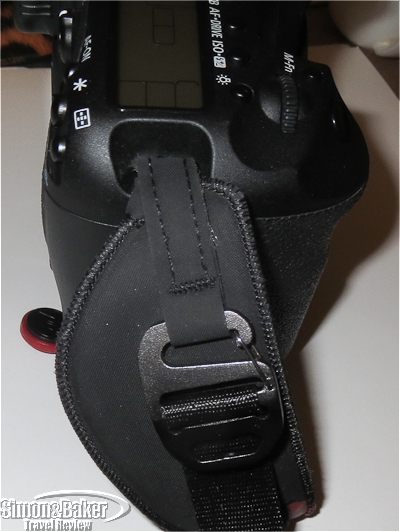
It was a matter of moments to set up the Clutch attachment to the camera
Peak Design took the mundane camera strap and updated every aspect of it. They improved the method of attachment, how it is adjusted, the options for carrying the camera and enhanced my overall experience as a photographer. I plan to continue to use those straps as part of my ongoing equipment configuration. The Peak Design mission of enabling “photographers, adventurers and outdoors enthusiasts to better capture the beautiful world around them” appealed to me. I was pleased to discover the products fulfilled this mission for my purposes. Peak Design, 2325 3rd Street Suite 410, San Francisco, California 94107, http://peakdesignltd.com
+1 312.203.8427, info@peakdesign.com.
by Editor | Sep 8, 2014 | Attractions, Food and Wine, Luxury Travel
Article and photos by Josette King
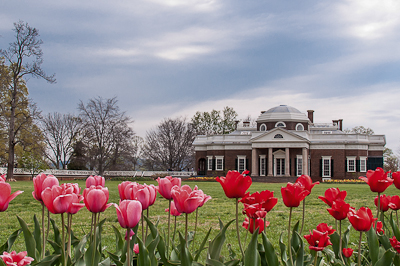
The rear of Monticello overlooked vast expanses of lawns and flower borders
This was my first visit to Charlottesville, Virginia, a small historic city with a big reputation. I admit I approached it with a degree of skepticism. Everyone I knew who had ever visited had come back smitten and daydreaming about settling there. Surely, no place could be that idyllic? Charlottesville was.
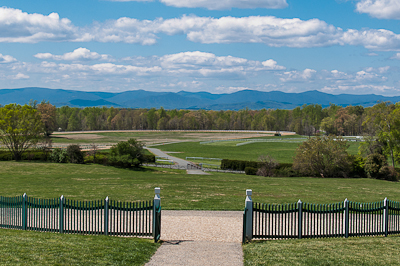
Montpelier offered stunning views of the Blue Ridge Mountains
Although a mere 115 miles (185 kilometers) from Washington, D.C. and 70 miles (110 kilometers) from Richmond, this small Central Virginia city nestled in the picturesque rural foothills of the Blue Ridge Mountains had, in spite of its popularity, retained the charm and tranquil pace of earlier times. Its once Main Street was now the Downtown Mall, an eight block tree shaded pedestrian walkway lined with restored historic buildings. There, antique shops, art galleries and all manner of fashion boutiques mingled with café terraces, restaurants, pubs and several movie and live performance theaters. A favorite spot for tourists as well as local people had a Freedom of Expression Wall where passersby could pen (in chalk) what was on their mind, which I was told included the occasional marriage proposal. The wall was erased each night to give others an opportunity to have their say.

Passersby were welcome to scroll their thoughts on the Freedom of Expression Wall
Charlottesville has conserved to this day the enduring mark imparted upon it two centuries ago by its most illustrious citizen, Thomas Jefferson. In addition to his Monticello home, he founded and designed the University of Virginia. Both of the neoclassical (or Jeffersonian style) masterpieces are now UNESCO World Heritage Sites. Today, Monticello attracts half a million visitors annually and the University of Virginia, with its yearly enrollment of over 23,000 students, contributes significantly to the cultural vitality of the area.
Jefferson also made a significant impact on the landscape of the area, albeit posthumously, when he attempted to establish vineyards on land adjoining Monticello, only to have his efforts thwarted by the start of the Revolutionary War in 1774. In the latter part of the 20 century, a handful of determined growers were inspired to revisit his vision to develop the Central Virginia vineyards.

The tasting room at Jefferson Vineyards Winery
Today, Virginia has over 2,000 acres (810 hectares) of vineyards, half of them around Charlottesville. Almost 30 of the wineries form the Monticello Wine Trail and welcome visitors in their tasting rooms. A well mapped itinerary took me along some of the loveliest back roads of the greater Charlottesville area. One of the oldest, Jefferson Vineyards, was within a stone’s throw of Monticello, on the very land where Jefferson made his own wine growing attempt.
In addition to Thomas Jefferson, the Charlottesville area was also home to two more of America’s Founding Fathers, James Monroe and James Madison. All three became President of the United States and their respective homes Monticello, Ash Lawn Highland and Montpelier were open to tourists. I combined their visit, in an itinerary known as the Presidents Trail, with that of nearby wineries. Along the way, I soon discovered that the bucolic setting had drawn a large number of talented artists and craftspeople, whose studios and galleries made for an enjoyable visit as well.
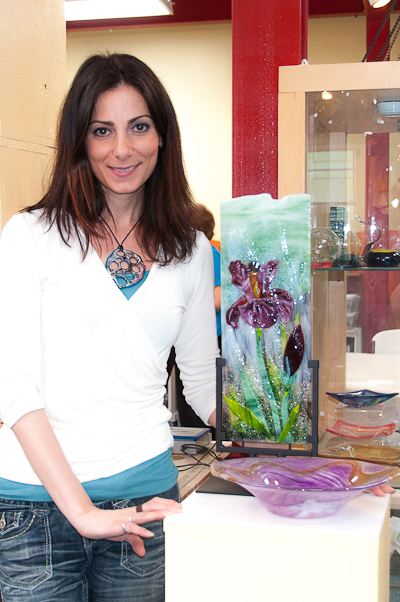
Glass artist Cara DiMassimo with some of her recent creations
With its charming rural environment, rich history, vibrant artistic life, inviting vintage downtown, wineries and more than a few notable restaurants to boot, I could see how Charlottesville could be an enjoyable place to live. It was an exceptional place to visit.
by Editor | Jun 9, 2014 | Luxury Travel
Article and photos by Josette King
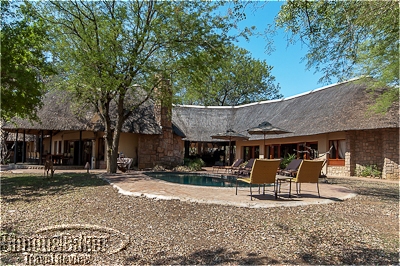
The lodge and swimming pool
In the local Shangaan language, so I had heard, shumbalala means “the place where lions sleep.” And I was headed to Shumbalala, the intimate luxury lodge located in the heart of South Africa’s Thornybush Game Reserve, known for the density of its resident population of lions as well as other Big Fives species (buffalo, elephant, leopard and rhino). My expectations were high. Even as I transferred from the car that had brought me from nearby Hoedspruit Eastgate Airport to the Shumbalala open game viewing vehicle that met me at the gate (no private vehicles were allowed in Thornybush), I held my camera at the ready for lions.
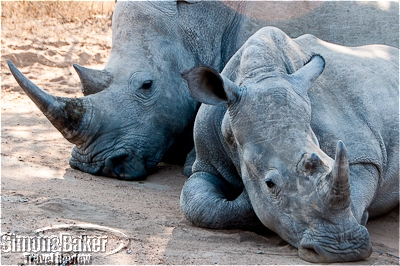
Rhinos enjoyed a nap in the shade
Moments later, I had forgotten about them. I was staring slack jawed at a scene I had never before experienced in my repeated visits to Africa: a tangle of rhinos, tightly huddled together in search of relief from the searing midday heat under the meager shade of a roadside tree.
Throughout my stay, while I enjoyed plenty of big cat sightings, leopards and cheetahs as well as the eponymous lions, rhinos commanded the limelight. Whether in a breeding herd with young calves grazing in the sunset or in groups of mature males crashing determinedly through the bush, they were an awesome sight. And like the other big game I encountered around Thornybush, these often shy behemoths were sufficiently habituated to humans that they all but ignored our presence, allowing for an outstanding opportunity to observe and photograph them at length and at close range.

The sleeping area of Suite Number Three
At Shumbalala, game viewing was only the beginning of an exceptional safari experience in the grand South African tradition. Nestled in a shaded grove at the edge of a seasonal river, reduced to a busy water hole when I visited at the height of the dry season, the property was a secluded oasis of classic elegance in the midst of a great swath of pristine open bush. With its spacious main lodge and only five guestrooms, each a cozy free standing thatched structure, Shumbalala offered the opulent comfort of an African country manor of a bygone era and the personalized hospitality to which only an intimate boutique property can aspire.
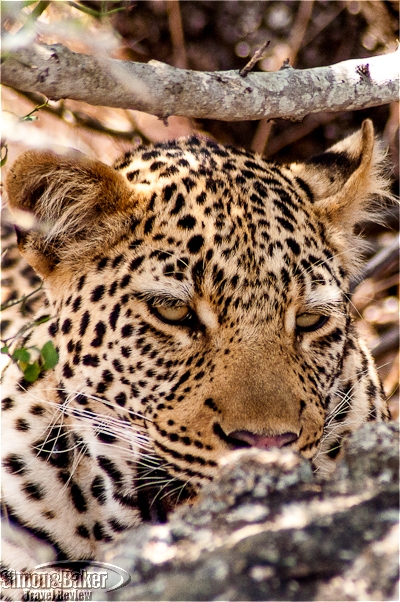
We came across this leopard concealed in the underbrush
The meals as well as the early morning and late afternoon game drives punctuated the days with enjoyable convivial interludes. From a hearty late morning brunch, bountiful mid afternoon high tea and elegant five course evening dinner, and some snack opportunities in between, every dish was beautifully prepared and served; and the cuisine was an artful blend of local specialties and international classics.
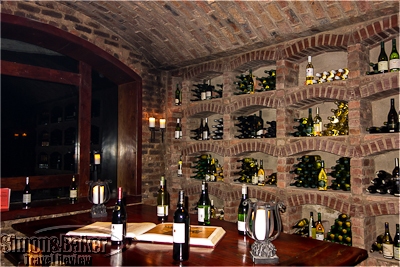
The wine cellar
Another notable feature of Shumbalala was its state of the art wine cellar. It was a lovely pre-dinner treat to visit the romantic vaulted space and select from a number of excellent South African labels a bottle to enhance my evening’s menu.
With its superb accommodations and hospitality, excellent game viewing opportunities and easy road and air access from the international hub of Johannesburg, Shumbalala was an ideal destination for travelers who preferred an easy one stop luxury safari experience. I personally found it an outstanding stop in my regional itinerary of game reserves and national parks.

A Shumbalala sunset








































